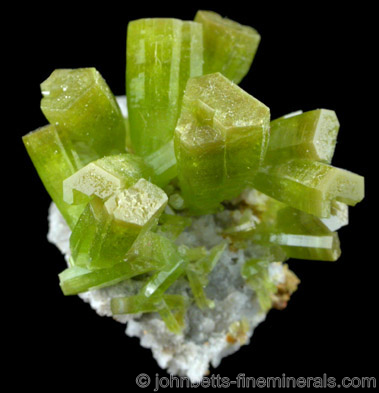The Mineral pyromorphite

Pyromorphite is a member of the Apatite group, a group of
isomorphous hexagonal minerals. It is very similar in structure
and appearance to Mimetite, and may be partially replaced
by it. In fact, sometimes Pyromorphite and Mimetite are virtually
indistinguishable from each other and may be wrongly labeled as the
other.
Chemical Formula
Pb5(PO4)3Cl
Color
Light to dark green, yellow-green, greenish-white, brownish-green, brown, orange, gray, and white. May also be multicolored green and orange.
Uses
Pyromorphite is a minor ore of lead where it occurs with more abundant lead minerals. It is also a popular mineral among collectors, especially specimens from classic occurrences, as well as newer finds of bright neon green Pyromorphite which command very high prices.
Noteworthy Localities
This mineral contains many classic and exceptional localities. High up on the list is the Bad Ems District, Rhineland, Germany, where large stubby, and often brownish crystals are affectionately called "Emser Barrels". Other very famous and classic European localities are the Les Farges Mine, Correze, France; Cordoba, Andalusia, Spain; El Horcajo, Ciudad Real, Spain; and Caldbeck Fells, Cumbria, England. Fine globular and mammilary Pyromporphite comes from the S'Ortu Becciu Mine in Cagliari Province, Sardinia, Italy.
Many outstanding specimens have recently been coming out of China, with an exceptional brilliant apple-green color that almost looks too artificial to be real. These specimens come from the Daoping and adjacent Yangshuo Mine in Gongcheng, Guangxi, China.
Australia also contains many fabulous occurrences, specifically Broken Hill, New South Wales; the Rum Jungle, Batchelor, Northern Territory; the Black Star Mine, Mount Isa, Queensland; and Zeehan, on the island of Tasmania. Large plates have come from the Broken Hill Mine, Kabwe, in the African country of Zambia.
In Mexico, light green crystals associated with Wulfenite come from Mapimi, Durango; and nice crystal clusters from the
San Luis Mine, San Jose, Chihuahua. In Canada, specimens were found in the Society Girl Mine in Moyie, British Columbia.
In the U.S., the finest specimens are from the Coeur d'Alene District in Shoshone Co., Idaho. This area has several prolific mines, with the most notable being the Bunker Hill Mine in Kellogg, where outstanding green and orange crystals and sparkling globular masses were found. The most classic U.S. locality is Phoenixville, Chester Co., Pennsylvania, which has produced some famous old-time examples, especially from the famed Wheatley Mines. Another old locality, which contains mostly microcrystals, is the Loudville Lead Mine, in Easthampton, Hampshire Co., Massachusetts.
Distingushing Similar Minerals
Mimetite - Usually yellower in color, and less commonly in hollow crystals. Otherwise cannot be distinguished with simple methods.
Vanadinite - Usually more red in color, has a slightly yellow streak, and is slightly softer. Otherwise cannot be distinguished with simple methods.
Apatite - Harder (5).